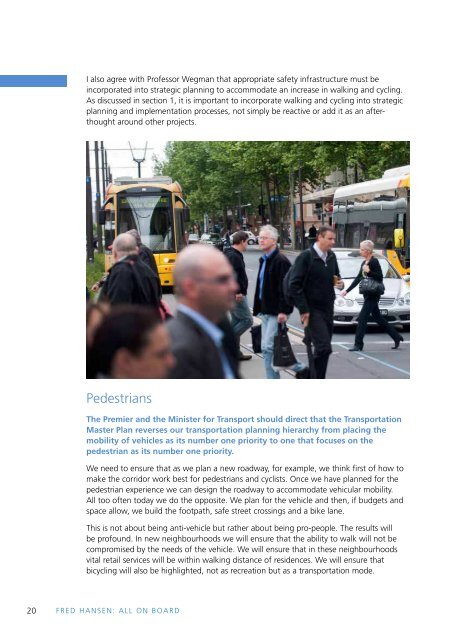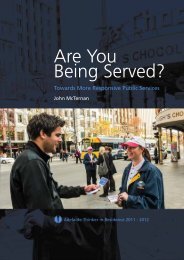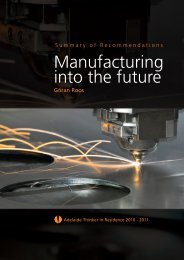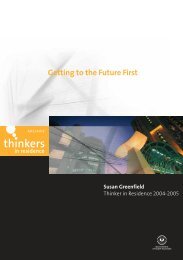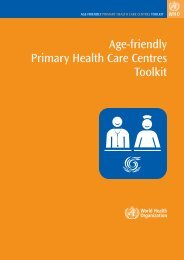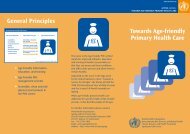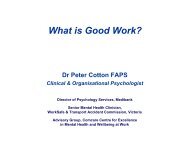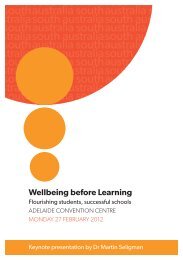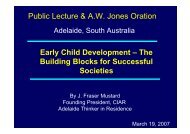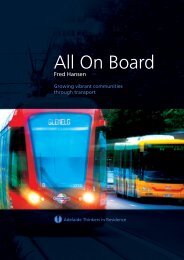Download pdf of Fred Hansen's report - Adelaide Thinkers in ...
Download pdf of Fred Hansen's report - Adelaide Thinkers in ...
Download pdf of Fred Hansen's report - Adelaide Thinkers in ...
- No tags were found...
You also want an ePaper? Increase the reach of your titles
YUMPU automatically turns print PDFs into web optimized ePapers that Google loves.
I also agree with Pr<strong>of</strong>essor Wegman that appropriate safety <strong>in</strong>frastructure must be<strong>in</strong>corporated <strong>in</strong>to strategic plann<strong>in</strong>g to accommodate an <strong>in</strong>crease <strong>in</strong> walk<strong>in</strong>g and cycl<strong>in</strong>g.As discussed <strong>in</strong> section 1, it is important to <strong>in</strong>corporate walk<strong>in</strong>g and cycl<strong>in</strong>g <strong>in</strong>to strategicplann<strong>in</strong>g and implementation processes, not simply be reactive or add it as an afterthoughtaround other projects.PedestriansThe Premier and the M<strong>in</strong>ister for Transport should direct that the TransportationMaster Plan reverses our transportation plann<strong>in</strong>g hierarchy from plac<strong>in</strong>g themobility <strong>of</strong> vehicles as its number one priority to one that focuses on thepedestrian as its number one priority.We need to ensure that as we plan a new roadway, for example, we th<strong>in</strong>k first <strong>of</strong> how tomake the corridor work best for pedestrians and cyclists. Once we have planned for thepedestrian experience we can design the roadway to accommodate vehicular mobility.All too <strong>of</strong>ten today we do the opposite. We plan for the vehicle and then, if budgets andspace allow, we build the footpath, safe street cross<strong>in</strong>gs and a bike lane.This is not about be<strong>in</strong>g anti-vehicle but rather about be<strong>in</strong>g pro-people. The results willbe pr<strong>of</strong>ound. In new neighbourhoods we will ensure that the ability to walk will not becompromised by the needs <strong>of</strong> the vehicle. We will ensure that <strong>in</strong> these neighbourhoodsvital retail services will be with<strong>in</strong> walk<strong>in</strong>g distance <strong>of</strong> residences. We will ensure thatbicycl<strong>in</strong>g will also be highlighted, not as recreation but as a transportation mode.Mak<strong>in</strong>g the pedestrian and cyclist modes a priority <strong>in</strong> the transportation plann<strong>in</strong>g hierarchyis not reserved just for new projects. Every time there is to be an <strong>in</strong>vestment <strong>in</strong>transportation <strong>in</strong>frastructure, from repav<strong>in</strong>g a stretch <strong>of</strong> street to rebuild<strong>in</strong>g amajor <strong>in</strong>tersection, the role <strong>of</strong> the pedestrian should be placed front and centre.No project should be allowed to proceed if it has not done so. And each project that doesproceed must dramatically enhance the pedestrian experience.When this happens, it will also help <strong>in</strong> deliver<strong>in</strong>g efficient public transportation options.Efficient public transportation means that the catchment <strong>of</strong> potential riders is expanded bythe pedestrian-friendly neighbourhood, result<strong>in</strong>g <strong>in</strong> more seats on the bus, tra<strong>in</strong> or trambe<strong>in</strong>g filled. The importance <strong>of</strong> this cannot be overstated.It will also result <strong>in</strong> neighbourhoods where people want to live and raise their families,because they will be neighbourhoods where children can safely walk or bike to school,where the elderly can walk to the store or to see friends, and where our environmentalimpact will be lessened. You will create and build healthier and more susta<strong>in</strong>ableneighbourhoods. It will mean that the use <strong>of</strong> vehicles will be reduced – not elim<strong>in</strong>ated, butused only for those necessary trips where walk<strong>in</strong>g or bicycl<strong>in</strong>g is not an option.In Portland, Oregon’s newest neighbourhood, the Pearl District, the public transportoutcomes have been startl<strong>in</strong>g. Citizens <strong>in</strong> this t<strong>in</strong>y neighbourhood are 11.5 times morelikely to take transit, 4.5 times more likely to walk, and 2.4 times more likely to bike thancitizens <strong>in</strong> the rest <strong>of</strong> the greater Portland region. They are also driv<strong>in</strong>g about half as muchand own half as many vehicles as their counterparts <strong>in</strong> the region as a whole.This same experience has been repeated each time communities have re<strong>in</strong>ventedthemselves to focus on the pedestrian and cyclist. Wonderful examples exist <strong>in</strong> Bilbao,Spa<strong>in</strong>; Freiburg, Germany; Dubl<strong>in</strong>, Ireland; and countless other locations around the globe.A sense <strong>of</strong> communityStreet activation is <strong>of</strong>ten thought <strong>of</strong> at street level, but is less <strong>of</strong>ten considered at height,and yet it is no less crucial to improved pedestrian amenity. Key to a safe and welcom<strong>in</strong>gpublic doma<strong>in</strong> is a sense <strong>of</strong> community, <strong>of</strong> shared experience, and <strong>of</strong> what is <strong>of</strong>tencalled ‘passive surveillance’: eyes on the street. This should be delivered on the groundlevel where accessible and engag<strong>in</strong>g shopfronts, lobbies and residential liv<strong>in</strong>g spacescan enliven the footpath. More busy people transit<strong>in</strong>g, transact<strong>in</strong>g and <strong>in</strong>teract<strong>in</strong>g willgenerally result <strong>in</strong> a safer, more vibrant and desirable place. People are attracted to people.But ‘passive surveillance’ can also be effective when higher level apartments andcommercial uses are able to look over the street from balconies, or even zero setbacks,active ro<strong>of</strong> terraces and the like to encourage a closer connection between occupants andpedestrians.Car access onto properties must be carefully considered. Just as <strong>in</strong>active garage frontagesare a problem for streets, ramps and driveways <strong>in</strong>to common carparks can produceun<strong>in</strong>tended consequences if not well located, and well designed. Where practicable, entryto common carparks should be from laneways or service streets, not primary frontages.Across these entries, pedestrian footpaths should cont<strong>in</strong>ue, and not be broken by kerbs,gutters, refuge islands and the like. Instead, cars should be rem<strong>in</strong>ded they are travers<strong>in</strong>gP U T T I N G P E D E S T R I A N S A N D B I C Y C L I S T S A T T H E C E N T R E20 FRED HANSEN: ALL ON BOARDFRED HANSEN: ALL ON BOARD 21


